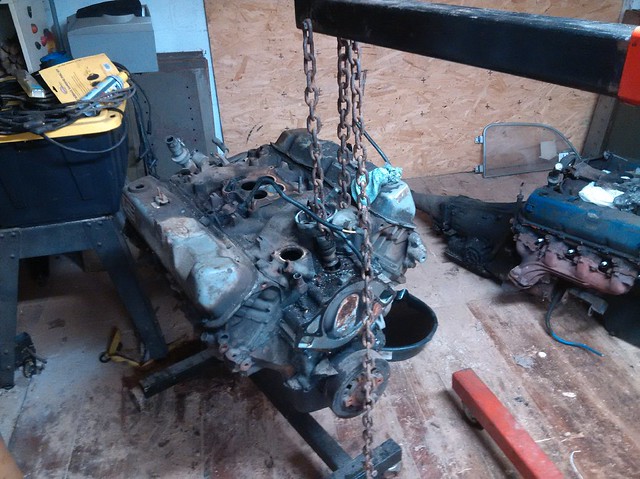Or would you prefer a nice game of chess? ![]()
Our LeMons team has decided to build a new 460 for our LeMons car, a 1975 LTD Landau. As-raced weight is somewhere in the neighborhood of 4000 pounds. We currently run a mostly-stock 460, bored .060 to 472, with advanced cam timing, a windage tray, 0.030" head gaskets, a 625 CFM Edelbrock carb (jetted richer using an A/F meter) on an aluminum dual plane intake, and factory...well, everything else. Automatic trans (C6) and a 3.25 final drive ratio. It runs pretty well, but has a few races under it's belt now, so we're thinking about building up something a bit...hotter.
Enter the new lump: a 30,000 mile engine pulled out of a 1985 Ford motorhome. It's as factory as they come, down to the chalk markings on the cylinder walls in the valley. Tuned up and brand new, it managed about 245 HP and 385 lb-ft.
We'd like, um, more, please. Of course, we have to do it cheaply.
We addressed some of the glaring deficiencies of the snog-era 460 with our current LeMons engine- the poor quench, the retarded cam timing, oil control - and now we want to take it a step further with things like pistons and a cam. Since this engine is so fresh, machine work will be kept to a minimum. (There isn't even a ring ridge at the top of the cylinder bore.)
Stock compression ratio (CR) was about 8.06:1 on this engine. The heads are D3VE, which have about 94 cc combustion chambers according to the internets. The pistons leave about 0.025" to the top of the deck, and the stock head gasket was about 0.050". The pistons have about a 22 cc dish to them, too. The stock cam is...well, it's best not to talk about that.
I know that D0VE heads are the ticket to high compression, with their ~77 cc chambers, but unfortunately I don't have a set of those laying around. And regardless of the head, the exhaust ports kinda universally suck, so some porting is in the plans there.
So the plan is to use the stock D3VE heads, port them, install some taller pistons with less dish, a thinner head gasket, and get CR up to about 9.5:1. This will also get quench down to about 0.040", a more reasonable number (currently it's about 0.075")
Then, the Big Question:
What Cam To Use?
...to be continued...









































